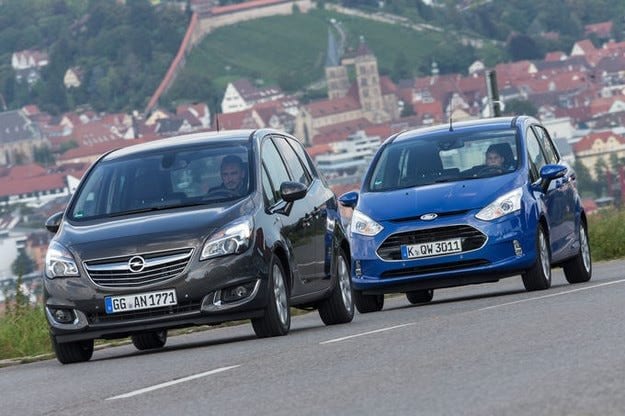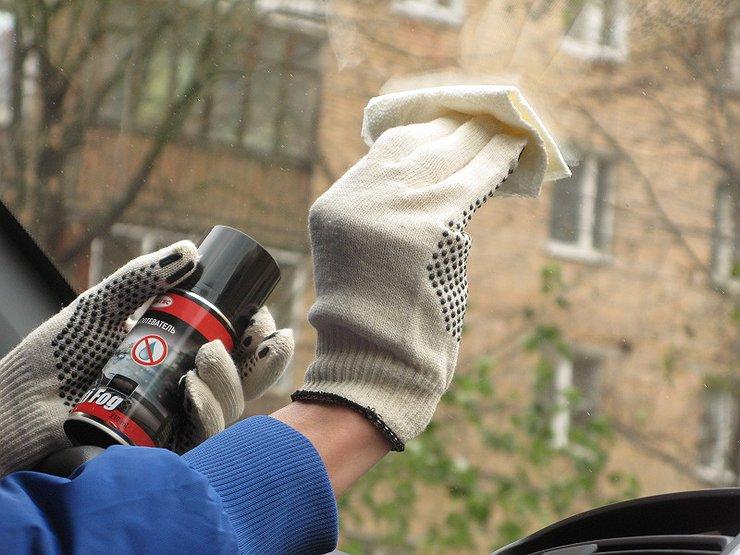
Test drive Ford B-Max 1.6 TDCi vs. Opel Meriva 1.6 CDTI: small on the outside, big on the inside

Comparison of two practical models with fuel-efficient diesel engines
However, before we take a look at what's behind those unusually designed doors, let's first take a close look at the two cars on the outside. The Meriva looks longer and wider than the Ford B-Max, and in fact the subjective impression turns out to be absolutely correct - the wheelbase of the Rüsselsheim model is 2,64 meters, while Ford is pleased with only 2,49 meters - the same as the cost of the Fiesta . The same goes for the predecessor Fusion, which was designed as a taller version of the smaller model.
Ford B-Max with a cargo volume of 318 liters
The Ford B-Max stays true to its predecessor's concept but far surpasses it in terms of functionality with an asymmetrically split rear seat and automatically lowering seat sections when the rear seats are folded down. When folded, even surfboards can be transported next to the driver in the car. However, this does not mean that the model is a transport miracle. With a face value of 318 liters, the trunk does not look very impressive, and its maximum capacity of 1386 liters is also far from a record.
The concept of doors, known from the Nissan Prairie from the 80s, and today can not be found in any representative of the modern car industry. There are no B-pillars between the front opening and rear sliding doors of the Ford B-Max, which should make it easier to get in and out. However, the exercise can only be performed with the entrance doors open. Meriva relies on pivoting rear doors that open to a large angle and make the installation of a child seat child's play.
More interior space and more comfort in Opel
Opel has also done very well in interior design: the three rear seats can be moved forward and backward separately, the middle of which can be folded down if necessary, and the two outer seats can be moved inward. Thus, the five-seater van becomes a four-seater carrier with very large space in the second row.
The Meriva's trunk holds between 400 and 1500 liters, and the payload of 506 kg also surpasses the B-Max at 433 kg. The same is true for a payload of 1200 kg for the Meriva and 575 kg for the Ford B-Max. The Opel is 172 kilograms heavier, and in some ways this has a positive effect on it.
For example, the Meriva's driving comfort is vastly improved and the solid body structure is a fact that is particularly evident due to the absence of any parasitic noise when driving on poorly maintained roads. The quality of workmanship in the interior is also commendable. The seats also deserve an excellent rating, as they provide impeccable comfort at any distance, especially in their ergonomic design.
Ford B-Max is easy to drive
In this regard, the Ford B-Max is definitely less convincing - in addition, the model suffers from poor performance of the air conditioning system. The operation of the audio system with CD, USB and Bluetooth is also unnecessarily complicated. The optional Opel IntelliLink system works much better. In addition to simple and convenient connection to a smartphone and other external devices, this system allows you to use various Internet functions and has voice control. Meriva also boasts a much better on-screen navigation system. Among the recommended options for both models is a rear-view camera, as neither car in the test boasts particularly good visibility from the driver's seat.
The Ford B-Max has some advantages in its more compact size - it is more agile, and its handling is more pronounced lightness and immediacy. Thanks to direct and informative steering, it is more dynamic in corners than the rather calm Meriva. On the other hand, the B-Max requires two meters more stopping distance from XNUMX km/h to a standstill.
It is interesting to note that although the Rüsselsheim model is significantly heavier and the power of the two engines is identical (95 hp), the Opel transmission is noticeably more temperamental. Against the 215 Nm of 1750 rpm that Ford has, Opel is up against 280 Nm, which is achieved at 1500 rpm, and this gives it a significant advantage in terms of dynamics and especially in intermediate acceleration. Suffice it to say that in sixth gear (which the Ford B-Max does not have), the Opel accelerates from 80 to 120 km / h faster than the B-Mach in fifth gear. In the test, the Meriva, equipped as standard with the Start-Stop system, showed a consumption of 6,5 l / 100 km, while its competitor was satisfied with 6,0 l / 100 km.
CONCLUSION
The Ford B-Max continues to impress with its spontaneous handling and low fuel consumption, while being more spacious and practical than the standard Fiesta. Opel Meriva is the best deal for anyone looking for a complete van with exquisite comfort for long journeys, impeccable workmanship and maximum interior flexibility.
Text: Bernd Stegemann
Photo: Ahim Hartmann
Home " Articles " Blanks » Ford B-Max 1.6 TDCi vs. Opel Meriva 1.6 CDTI: small on the outside, big on the inside
